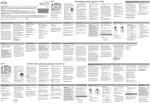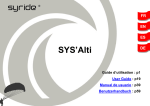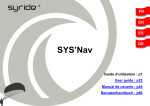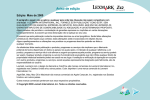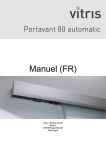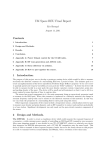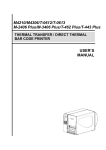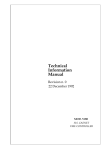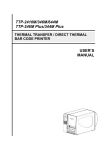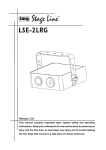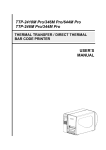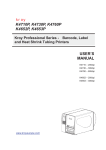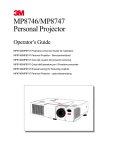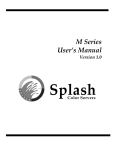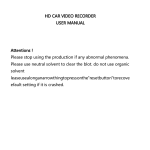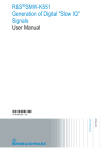Download User manual PySyCache 3.0
Transcript
User manual PySyCache 3.0 Copyright (c) 2006 - Vincent DEROO Permission is granted to copy, distribute and/or modify this document under the terms of the GNU Free Documentation License, Version 1.2 or any later version published by the Free Software Foundation; with no Invariant Sections, no Front-Cover Texts, and no Back-Cover Texts. A copy of the license is included in the section entitled "GNU Free Documentation License". User manual PySyCache 3.0 Tableof content 1.Overview.......................................................................................................................................................................................3 2.Installation.....................................................................................................................................................................................4 Requirements..............................................................................................................................................................................4 Installation of the required libraries...........................................................................................................................................4 PySyCache's installation............................................................................................................................................................4 Additional themes installation....................................................................................................................................................4 3.PySyCache's configuration...........................................................................................................................................................5 4.Interface presentation....................................................................................................................................................................6 Using keyboard and mouse with PySyCache.............................................................................................................................6 5.Arrange your preferences..............................................................................................................................................................7 6.The "Move" activity......................................................................................................................................................................8 Educational object......................................................................................................................................................................8 Activity rules..............................................................................................................................................................................8 Présentation of the screen area...................................................................................................................................................8 Available Themes by default......................................................................................................................................................8 7.The "Click" activity....................................................................................................................................................................10 Educational object....................................................................................................................................................................10 Activity rules............................................................................................................................................................................10 Presentation of the screen area.................................................................................................................................................10 Available Themes by default....................................................................................................................................................11 8.The "Buttons" activity.................................................................................................................................................................13 Educational object....................................................................................................................................................................13 Activity rules............................................................................................................................................................................13 Presentation of the screen areas...............................................................................................................................................13 Available themes by default.....................................................................................................................................................13 9.The "double-click" activity.........................................................................................................................................................15 Educational object....................................................................................................................................................................15 Activity rules............................................................................................................................................................................15 Presentation of the screen areas...............................................................................................................................................15 Available themes by default...............................................................................................................................................16 10.The "drag'n'drop" activity.........................................................................................................................................................17 Educational object....................................................................................................................................................................17 Activity rules............................................................................................................................................................................17 Presentation of the screen areas...............................................................................................................................................17 Avalaible theme by default......................................................................................................................................................17 User manual PySyCache 3.0 1.Overview PySyCache is an educational software: for young children (4 to 7 years old) the targeted users of PySyCache are young kids, but they may be older (i.e. users which aren't used to computers) or disabled persons (PySyCache used in their rehabilitation) which main purpose is helping them in using the mouse like: mouse movements clicks (with left, right or middle buttons) drag and drop. PySyCache was thought for an optimal use: interface adapted to young people: the mouse cannot leave the zone of the screen, impossible to click by inadvertency at the time of an activity on a button, adaptation of the levels: for each activity, there are three levels of difficulty (means, easy, difficult) and two modes of plays (free or directed), On the principal menu, the activities suggested go in a logical order of use of the mouse: displacement, click, doubleclick then drag'n drop. Pysycache doesn't require a powerful computer (1GHz processor and 512MB of RAM), and can be used: at home with your children at school. PySyCache has been created by Vincent DEROO in 2005 ; it has been tranlated in several languages (english, german, italian, spanish, portuguese, dutch, finnish) ; 2.0 and 2.1 versions were downloaded 4 000 times by users who are located in thirty countries. PySyCache is part of some curriculum (In Spain or Quebec). Several articles had been written about PySyCache. License: PySyCache is licensed under the GPL V2 licence. The current documentation is under the GFDL On PySyCache Web Site (http://www.pysycache.org/) you could find : some documentation for each activity (rules, FAQ, themes detail) last version of the software additional themes link (http://themes.pysycache.free.fr/) some users testimonials User manual PySyCache 3.0 2.Installation Requirements To run PySyCache, you need python (http://www.python.org/) and pygame (http://www.pygame.org/). PySyCache is known to work on FreeBSD, Linux, Macintosh and Windows operating systems. : Linux (Debian, Mandriva, SuSE, Ubuntu), Macintosh (G3) et Windows XP. Installation of the required libraries Linux platform: python and pygame belong to all the recent distributions. platform Macintosh: the installation of python is easy, but that of pygame more complicated. However, if one follows the instructions of the site www.pygame.org, the installation is held correctly and functions of the first blow. Binary copies of files for Macinstosh are available on the site of PySyCache. However, the installation of these libraries is useless if you install PySyCache from the pysycache.app file. Windows platform: the installeurs python and pygame are available since the sites of these libraries or on the site of PySyCache where a copy is available. However, the installation of these libraries is useless if you install PySyCache starting from the provided setup file : indeed, this one integrates already the libraries python and pygame. PySyCache's installation Linux platform: either using script.install.sh present in the file which you downloaded either using your manager of packages (PySyCache packages are available for various distributions: Debian, Mandriva, Slackware). platform Macintosh: either using script.install.sh present in the file which you downloaded. either using the file pysycache.app Windows platform: either using the file install beats.beats present in the file which you downloaded either using the setup that you downloaded. FreeBSD platform: a bearing was carried out (see the heading remote loading of the site of pysycache). Installation of additional topics. Additional themes installation For reasons of size and licence, PySyCache is delivered with some themes by defect, but it is possible: to create your own topics: in the repertory Doc. of pysycache, you find scripts-fu for gimp and the files allowing to create its masks, its parts of puzzle to install additional topics provided by PySyCache: it is then enough to decompress the file which you downloaded in the repertory of PySyCache (the tree structure is created automatically). The additional themes are subjected to a licence of the Creative type commons and often do not authorize a commercial use of it. User manual PySyCache 3.0 3.PySyCache'sconfiguration PySyCache is very flexible of use: for example, it is possible for you to create your own topics and to store them in your personal repertory. PySyCache manages its users in two ways: Independent users: in the case of a user on a machine or several users on the same machine, but with various accounts Gathered Users: in the case of several users on the same machine with the same account. The interest of this regrouping is to provide various levels of difficulty for various users without having to connect/disconnect from the machine. The choice of this management of the users makes that with the launching of PySyCache, its identity should be chosen: The configuration of PySyCache is regulated by launching PySyCache with the option “- admin”. It is done automatically during the first launching of PySyCache: You must then specify: how users are managed, the directory where the themes and the configuration file of users are stored (if the users are managed by PySyCache) the directory of the scores. User manual PySyCache 3.0 4.Interfacepresentation Keyboard shortcuts For not over load the screen, the buttons visibility is different according to the user level. But, actions can be executed from the keyboard . The following table shows the buttons visibility: Button Shortcut Level of display mode (associated difficulty level) Simply (easy) Normal (middle) Full (difficult) F3 YES YES YES Previous picture of the theme Left arrow NO YES YES Next picture of the theme Right arrow NO YES YES Up arrow NO NO YES Game mode (free/directed) F4 NO NO YES Chronometer F5 NO NO YES Change the theme Level button You change the visibility by typing F2 if one time you need to view some buttons. Explication on the chronometer usage Chronometer is available only for the « difficult » level, several pictures indicate the leaving time : more than 30 seconds to finish activity between 15 and 30 seconds to finish activity between 5 and 15 seconds to finish activity less than 5 seconds to finish activity User manual PySyCache 3.0 5.Arrangeyourpreferences Your preferences permit you to customize PySyCache: that way you don't have to give any option each time you run it. For You must then specify: choice of the screen mode (fullscreen or windowed 800x600) with sound or muted default level selection: three levels are available (easy, medium or difficult). This level will be used at the beginning of an activity, but you may change it during the game. Click on arrows for changing the level. transition speed between two screens (the higher the number is the longer the transition will last. A zero value means a very quick transition) your selected language for the menus (not the ABCBook or themes numbers). The available languages are read from the directory Don't forget to save your preferences (click on floppy disk button). When the preferences are saved, they are made available immediately. User manual PySyCache 3.0 6.The"Move"activity Educational object To learn to move mouse on screen area. Activity rules The principle is that child must uncover a picture hidden by a cache. For this, the movements of the mouse erase the cache and step by step, the picture appears. Présentation of the screen area 1. 2. 3. 4. 5. 6. 7. Chronometer activation (only for difficult level) : child have 60 seconds for uncover all the picture... and enter in the 8 best times ! selection of the game mode :' "normal" : you have to uncover the picture "ghost" : you have to uncover the picture... but each second, a cache that have disappeared, appears again ! button for select the level of the activity (and adjusts it with the children age) : easy : cache size : 120x90 pixels (6 cols x 6 rows) middle : cache size : 72 x 54 pixels (10 cols et 10 rows) difficult : cache size : 48 x 36 pixels (15 cols et 15 rows). button for select the previous and next pictures in the theme (you can use the left and right arrows of the keyboard). button for select the theme : you click on the button and the theme changes immediatly. button for quit the activity. mouse uncovering the picture. Available Themes by default ABC Numbers User manual PySyCache 3.0 User manual PySyCache 3.0 7.The "Click"activity Educational object To learn to click with buttons (any of them) on pictures areas. Activity rules The child must find photographies hidden in a landscape. In this order, it must move it's mouse over all the screen area : when it ear a "beep" or when the camera is coloured in red it's meens that the mouse have found the photography and that child can click. Presentation of the screen area 1. 2. 3. 4. 5. 6. 7. Chronometer activation (only for difficult level) : child have 60 seconds for find all the picture... and enter in the 8 best times ! selection of the game mode : "normal" : you have to search photographies "ghost" : you have to search an accurate photography marked by a yellow spot. button for select the level of the activity (and adjusts it with the children age) : easy : Camera becomes red when it is located less that 50 pixel of the photography middle : Camera becomes red when it is located less that 35 pixel of the photography difficult : Camera becomes red when it is located less that 20 pixel of the photography. button for select the previous and next lists of photographies in the same theme. button for select the theme : you click on the button and the theme changes immediatly. button for quit the activity. mouse over the picture : normal moving camera that have found a photography : don't forget to click for see it 8. List of photographies to find : photography don't have be taken photography have already been taken photography to found in the ghost mode User manual PySyCache 3.0 Available Themes by default Dinosaurs Sea User manual PySyCache 3.0 8.The"Buttons"activity Educational object To learn to click with left, right or central button of the mouse. Activity rules Child must bring all same items in the correct area of landscape. For this, il must click on items for drive them at right or left with the correct button of the mouse. Presentation of the screen areas 1. 2. 3. 4. 5. 6. 7. 8. Chronometer activation (only for difficult level) : child have 60 seconds for uncover all the picture... and enter in the 8 best times ! selection of the game mode : "normal" : you have to lead an animal to it's home "ghost" : you have to lead an acurate animal to it's home (it is choiced by pysycache and it's color is differents, other are in grey ) button for select the level of the activity (and adjusts it with the children age) : easy : slow speed middle : normal speed difficult : high speed. button for select the previous and next pictures in the theme (you can use the left and right arrows of the keyboard). button for select the theme : you click on the button and the theme changes immediatly. button for quit the activity mouse and available actions : left button : the animal moves to left middle button : the animal reverses it's movement right button : the animal moves to the right The child must bring the animal in the destination area until it's disappears. destination area of the left animal. Available themes by default Ice Bee Wolf User manual PySyCache 3.0 Crapaud User manual PySyCache 3.0 9.The"double-click"activity Educational object To learn to double-click on an unmoved element. Activity rules Child must catch items by double-clicking on them. Presentation of the screen areas 1. 2. 3. 4. 5. 6. 7. 8. Chronometer activation (only for difficult level) : child have 60 seconds for uncover all the picture... and enter in the 8 best times ! selection of the game mode : "normal" : you have to double-click on the item you want "ghost" : you have to double-click on the item that PySyCache have selected for you. button for select the level of the activity (and adjusts it with the children age) : easy : Items appears one by one. The delay for double-click is 900/1000 of second middle : Items appears by group of 3 or 4. The delay for double-click is 600/1000 of second difficult : Items appears by group of 3 or 4 but sometimes, one items disappears and reappears... so, user must double-click quickly ! The delay for double-click is 300/1000 of second. button for select the previous and next pictures in the theme (you can use the left and right arrows of the keyboard). button for select the theme : you click on the button and the theme changes immediatly. button for quit the activity. mouse on the screen with items to double-click. list of items to double-click : item don't have been clicked item have already been clicked item (choiced by PySyCache) to double-click in the ghost mode. User manual PySyCache 3.0 Availablethemesby default Butterfly Apple and pear User manual PySyCache 3.0 10.The"drag'n'drop"activity Educational object To learn to move a visual element on screen. Activity rules Child must make a jigsaw by drag and drop pieces at their correct location. Presentation of the screen areas 1. 2. 3. 4. 5. 6. 7. 8. Chronometer activation (only for difficult level) : child have 60 seconds for make the jigsaw... and enter in the 8 best times ! selection of the game mode : "normal" : you have to place the piece that you want "ghost" : you have to place the correct piece that pysycache indicate you. button for select the level of the activity (and adjusts it with the children age) : easy : Jigsaw is made with simply pieces or 4 pieces. The acceptable distance with the correct position is 40 pixels. middle : Jigsaw is made with 6 to 16 pieces. The acceptable distance with the correct position is 30 pixels. difficult : Jigsaw is made with more than 16 pieces. The acceptable distance with the correct position is 20 pixels. button for select the previous and next pictures in the theme (you can use the left and right arrows of the keyboard). button for select the theme : you click on the button and the theme changes immediatly. button for quit the activity. box with all pieces of the jigsaw. button for navigate in the box with jigsaw pieces. When all pieces are putted, a new combinaison of jigsaw is randomized selected in the same theme. Avalaible theme by default Cartoons User manual PySyCache 3.0 User manual PySyCache 3.0 User manual PySyCache 3.0 11.GNUFreeDocumentationLicense Version 1.2, November 2002 Copyright (C) 2000,2001,2002 Free Software Foundation, Inc. 51 Franklin St, Fifth Floor, Boston, MA 02110-1301 USA Everyone is permitted to copy and distribute verbatim copies of this license document, but changing it is not allowed. 0. PREAMBLE The purpose of this License is to make a manual, textbook, or other functional and useful document "free" in the sense of freedom: to assure everyone the effective freedom to copy and redistribute it, with or without modifying it, either commercially or noncommercially. Secondarily, this License preserves for the author and publisher a way to get credit for their work, while not being considered responsible for modifications made by others. This License is a kind of "copyleft", which means that derivative works of the document must themselves be free in the same sense. It complements the GNU General Public License, which is a copyleft license designed for free software. We have designed this License in order to use it for manuals for free software, because free software needs free documentation: a free program should come with manuals providing the same freedoms that the software does. But this License is not limited to software manuals; it can be used for any textual work, regardless of subject matter or whether it is published as a printed book. We recommend this License principally for works whose purpose is instruction or reference. 1. APPLICABILITY AND DEFINITIONS This License applies to any manual or other work, in any medium, that contains a notice placed by the copyright holder saying it can be distributed under the terms of this License. Such a notice grants a world-wide, royalty-free license, unlimited in duration, to use that work under the conditions stated herein. The "Document", below, refers to any such manual or work. Any member of the public is a licensee, and is addressed as "you". You accept the license if you copy, modify or distribute the work in a way requiring permission under copyright law. A "Modified Version" of the Document means any work containing the Document or a portion of it, either copied verbatim, or with modifications and/or translated into another language. A "Secondary Section" is a named appendix or a front-matter section of the Document that deals exclusively with the relationship of the publishers or authors of the Document to the Document's overall subject (or to related matters) and contains nothing that could fall directly within that overall subject. (Thus, if the Document is in part a textbook of mathematics, a Secondary Section may not explain any mathematics.) The relationship could be a matter of historical connection with the subject or with related matters, or of legal, commercial, philosophical, ethical or political position regarding them. The "Invariant Sections" are certain Secondary Sections whose titles are designated, as being those of Invariant Sections, in the notice that says that the Document is released under this License. If a section does not fit the above definition of Secondary then it is not allowed to be designated as Invariant. The Document may contain zero Invariant Sections. If the Document does not identify any Invariant Sections then there are none. The "Cover Texts" are certain short passages of text that are listed, as Front-Cover Texts or Back-Cover Texts, in the notice that says that the Document is released under this License. A Front-Cover Text may be at most 5 words, and a Back-Cover Text may be at most 25 words. A "Transparent" copy of the Document means a machine-readable copy, represented in a format whose specification is available to the general public, that is suitable for revising the document straightforwardly with generic text editors or (for images composed of pixels) generic paint programs or (for drawings) some widely available drawing editor, and that is suitable for input to text formatters or for automatic translation to a variety of formats suitable for input to text formatters. A copy made in an otherwise Transparent file format whose markup, or absence of markup, has been arranged to thwart or User manual PySyCache 3.0 discourage subsequent modification by readers is not Transparent. An image format is not Transparent if used for any substantial amount of text. A copy that is not "Transparent" is called "Opaque". Examples of suitable formats for Transparent copies include plain ASCII without markup, Texinfo input format, LaTeX input format, SGML or XML using a publicly available DTD, and standard-conforming simple HTML, PostScript or PDF designed for human modification. Examples of transparent image formats include PNG, XCF and JPG. Opaque formats include proprietary formats that can be read and edited only by proprietary word processors, SGML or XML for which the DTD and/or processing tools are not generally available, and the machine-generated HTML, PostScript or PDF produced by some word processors for output purposes only. The "Title Page" means, for a printed book, the title page itself, plus such following pages as are needed to hold, legibly, the material this License requires to appear in the title page. For works in formats which do not have any title page as such, "Title Page" means the text near the most prominent appearance of the work's title, preceding the beginning of the body of the text. A section "Entitled XYZ" means a named subunit of the Document whose title either is precisely XYZ or contains XYZ in parentheses following text that translates XYZ in another language. (Here XYZ stands for a specific section name mentioned below, such as "Acknowledgements", "Dedications", "Endorsements", or "History".) To "Preserve the Title" of such a section when you modify the Document means that it remains a section "Entitled XYZ" according to this definition. The Document may include Warranty Disclaimers next to the notice which states that this License applies to the Document. These Warranty Disclaimers are considered to be included by reference in this License, but only as regards disclaiming warranties: any other implication that these Warranty Disclaimers may have is void and has no effect on the meaning of this License. 2. VERBATIM COPYING You may copy and distribute the Document in any medium, either commercially or noncommercially, provided that this License, the copyright notices, and the license notice saying this License applies to the Document are reproduced in all copies, and that you add no other conditions whatsoever to those of this License. You may not use technical measures to obstruct or control the reading or further copying of the copies you make or distribute. However, you may accept compensation in exchange for copies. If you distribute a large enough number of copies you must also follow the conditions in section 3. You may also lend copies, under the same conditions stated above, and you may publicly display copies. 3. COPYING IN QUANTITY If you publish printed copies (or copies in media that commonly have printed covers) of the Document, numbering more than 100, and the Document's license notice requires Cover Texts, you must enclose the copies in covers that carry, clearly and legibly, all these Cover Texts: Front-Cover Texts on the front cover, and Back-Cover Texts on the back cover. Both covers must also clearly and legibly identify you as the publisher of these copies. The front cover must present the full title with all words of the title equally prominent and visible. You may add other material on the covers in addition. Copying with changes limited to the covers, as long as they preserve the title of the Document and satisfy these conditions, can be treated as verbatim copying in other respects. If the required texts for either cover are too voluminous to fit legibly, you should put the first ones listed (as many as fit reasonably) on the actual cover, and continue the rest onto adjacent pages. If you publish or distribute Opaque copies of the Document numbering more than 100, you must either include a machinereadable Transparent copy along with each Opaque copy, or state in or with each Opaque copy a computer-network location from which the general network-using public has access to download using public-standard network protocols a complete Transparent copy of the Document, free of added material. If you use the latter option, you must take reasonably prudent steps, when you begin distribution of Opaque copies in quantity, to ensure that this Transparent copy will remain thus accessible at the stated location until at least one year after the last time you distribute an Opaque copy (directly or through your agents or retailers) of that edition to the public. It is requested, but not required, that you contact the authors of the Document well before redistributing any large number of copies, to give them a chance to provide you with an updated version of the Document. User manual PySyCache 3.0 4. MODIFICATIONS You may copy and distribute a Modified Version of the Document under the conditions of sections 2 and 3 above, provided that you release the Modified Version under precisely this License, with the Modified Version filling the role of the Document, thus licensing distribution and modification of the Modified Version to whoever possesses a copy of it. In addition, you must do these things in the Modified Version: A. Use in the Title Page (and on the covers, if any) a title distinct from that of the Document, and from those of previous versions (which should, if there were any, be listed in the History section of the Document). You may use the same title as a previous version if the original publisher of that version gives permission. B. List on the Title Page, as authors, one or more persons or entities responsible for authorship of the modifications in the Modified Version, together with at least five of the principal authors of the Document (all of its principal authors, if it has fewer than five), unless they release you from this requirement. C. State on the Title page the name of the publisher of the Modified Version, as the publisher. D. Preserve all the copyright notices of the Document. E. Add an appropriate copyright notice for your modifications adjacent to the other copyright notices. F. Include, immediately after the copyright notices, a license notice giving the public permission to use the Modified Version under the terms of this License, in the form shown in the Addendum below. G. Preserve in that license notice the full lists of Invariant Sections and required Cover Texts given in the Document's license notice. H. Include an unaltered copy of this License. I. Preserve the section Entitled "History", Preserve its Title, and add to it an item stating at least the title, year, new authors, and publisher of the Modified Version as given on the Title Page. If there is no section Entitled "History" in the Document, create one stating the title, year, authors, and publisher of the Document as given on its Title Page, then add an item describing the Modified Version as stated in the previous sentence. J. Preserve the network location, if any, given in the Document for public access to a Transparent copy of the Document, and likewise the network locations given in the Document for previous versions it was based on. These may be placed in the "History" section. You may omit a network location for a work that was published at least four years before the Document itself, or if the original publisher of the version it refers to gives permission. K. For any section Entitled "Acknowledgements" or "Dedications", Preserve the Title of the section, and preserve in the section all the substance and tone of each of the contributor acknowledgements and/or dedications given therein. L. Preserve all the Invariant Sections of the Document, unaltered in their text and in their titles. Section numbers or the equivalent are not considered part of the section titles. M. Delete any section Entitled "Endorsements". Such a section may not be included in the Modified Version. N. Do not retitle any existing section to be Entitled "Endorsements" or to conflict in title with any Invariant Section. O. Preserve any Warranty Disclaimers. If the Modified Version includes new front-matter sections or appendices that qualify as Secondary Sections and contain no material copied from the Document, you may at your option designate some or all of these sections as invariant. To do this, add their titles to the list of Invariant Sections in the Modified Version's license notice. These titles must be distinct from any other section titles. You may add a section Entitled "Endorsements", provided it contains nothing but endorsements of your Modified Version by various parties--for example, statements of peer review or that the text has been approved by an organization as the authoritative definition of a standard. You may add a passage of up to five words as a Front-Cover Text, and a passage of up to 25 words as a Back-Cover Text, to the end of the list of Cover Texts in the Modified Version. Only one passage of Front-Cover Text and one of Back-Cover Text may be added by (or through arrangements made by) any one entity. If the Document already includes a cover text for the same cover, previously added by you or by arrangement made by the same entity you are acting on behalf of, you may not add another; but you may replace the old one, on explicit permission from the previous publisher that added the old one. The author(s) and publisher(s) of the Document do not by this License give permission to use their names for publicity for or to assert or imply endorsement of any Modified Version. User manual PySyCache 3.0 5. COMBINING DOCUMENTS You may combine the Document with other documents released under this License, under the terms defined in section 4 above for modified versions, provided that you include in the combination all of the Invariant Sections of all of the original documents, unmodified, and list them all as Invariant Sections of your combined work in its license notice, and that you preserve all their Warranty Disclaimers. The combined work need only contain one copy of this License, and multiple identical Invariant Sections may be replaced with a single copy. If there are multiple Invariant Sections with the same name but different contents, make the title of each such section unique by adding at the end of it, in parentheses, the name of the original author or publisher of that section if known, or else a unique number. Make the same adjustment to the section titles in the list of Invariant Sections in the license notice of the combined work. In the combination, you must combine any sections Entitled "History" in the various original documents, forming one section Entitled "History"; likewise combine any sections Entitled "Acknowledgements", and any sections Entitled "Dedications". You must delete all sections Entitled "Endorsements." 6. COLLECTIONS OF DOCUMENTS You may make a collection consisting of the Document and other documents released under this License, and replace the individual copies of this License in the various documents with a single copy that is included in the collection, provided that you follow the rules of this License for verbatim copying of each of the documents in all other respects. You may extract a single document from such a collection, and distribute it individually under this License, provided you insert a copy of this License into the extracted document, and follow this License in all other respects regarding verbatim copying of that document. 7. AGGREGATION WITH INDEPENDENT WORKS A compilation of the Document or its derivatives with other separate and independent documents or works, in or on a volume of a storage or distribution medium, is called an "aggregate" if the copyright resulting from the compilation is not used to limit the legal rights of the compilation's users beyond what the individual works permit. When the Document is included in an aggregate, this License does not apply to the other works in the aggregate which are not themselves derivative works of the Document. If the Cover Text requirement of section 3 is applicable to these copies of the Document, then if the Document is less than one half of the entire aggregate, the Document's Cover Texts may be placed on covers that bracket the Document within the aggregate, or the electronic equivalent of covers if the Document is in electronic form. Otherwise they must appear on printed covers that bracket the whole aggregate. 8. TRANSLATION Translation is considered a kind of modification, so you may distribute translations of the Document under the terms of section 4. Replacing Invariant Sections with translations requires special permission from their copyright holders, but you may include translations of some or all Invariant Sections in addition to the original versions of these Invariant Sections. You may include a translation of this License, and all the license notices in the Document, and any Warranty Disclaimers, provided that you also include the original English version of this License and the original versions of those notices and disclaimers. In case of a disagreement between the translation and the original version of this License or a notice or disclaimer, the original version will prevail. If a section in the Document is Entitled "Acknowledgements", "Dedications", or "History", the requirement (section 4) to Preserve its Title (section 1) will typically require changing the actual title. User manual PySyCache 3.0 9. TERMINATION You may not copy, modify, sublicense, or distribute the Document except as expressly provided for under this License. Any other attempt to copy, modify, sublicense or distribute the Document is void, and will automatically terminate your rights under this License. However, parties who have received copies, or rights, from you under this License will not have their licenses terminated so long as such parties remain in full compliance. 10. FUTURE REVISIONS OF THIS LICENSE The Free Software Foundation may publish new, revised versions of the GNU Free Documentation License from time to time. Such new versions will be similar in spirit to the present version, but may differ in detail to address new problems or concerns. See http://www.gnu.org/copyleft/. Each version of the License is given a distinguishing version number. If the Document specifies that a particular numbered version of this License "or any later version" applies to it, you have the option of following the terms and conditions either of that specified version or of any later version that has been published (not as a draft) by the Free Software Foundation. If the Document does not specify a version number of this License, you may choose any version ever published (not as a draft) by the Free Software Foundation. How to use this License for your documents To use this License in a document you have written, include a copy of the License in the document and put the following copyright and license notices just after the title page: Copyright (c) YEAR YOUR NAME. Permission is granted to copy, distribute and/or modify this document under the terms of the GNU Free Documentation License, Version 1.2 or any later version published by the Free Software Foundation; with no Invariant Sections, no Front-Cover Texts, and no Back-Cover Texts. A copy of the license is included in the section entitled "GNU Free Documentation License". If you have Invariant Sections, Front-Cover Texts and Back-Cover Texts, replace the "with...Texts." line with this: with the Invariant Sections being LIST THEIR TITLES, with the Front-Cover Texts being LIST, and with the Back-Cover Texts being LIST. If you have Invariant Sections without Cover Texts, or some other combination of the three, merge those two alternatives to suit the situation. If your document contains nontrivial examples of program code, we recommend releasing these examples in parallel under your choice of free software license, such as the GNU General Public License, to permit their use in free software. User manual PySyCache 3.0



























